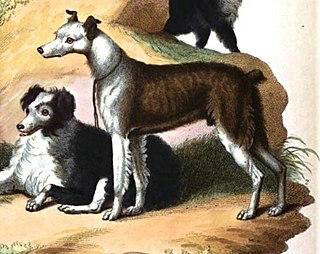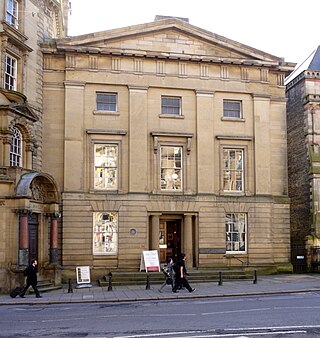Practical arrangements
In London The Oeconomist was circulated by Joseph Johnson. For towns not handled by Johnson there were separate arrangements with other booksellers, such as Joseph Cottle; [9] [10] the announcement in the Newcastle Courant of 9 December 1797 mentioned Benjamin Flower. [11]
It was subsidised by funds raised from Bigge, Wyvill and others. The price was reduced, from 3½d. to 2d., in February 1799; [12] or raised from 1½d. to 2d. [13] The woodcut for the cover was the work of Charlton Nesbit in 1797—it was attributed though to Thomas Bewick in the 19th century. [14] [15] The publication lasted until the end of the year, printed by M. Angus. [13]
Ritchie identifies the editor of The Oeconomist, working with Losh, instead as Thomas Bigge the brother of John Thomas Bigge, i.e. Thomas Hanway Bigge. [16]

Thomas Bewick was an English wood-engraver and natural history author. Early in his career he took on all kinds of work such as engraving cutlery, making the wood blocks for advertisements, and illustrating children's books. He gradually turned to illustrating, writing and publishing his own books, gaining an adult audience for the fine illustrations in A History of Quadrupeds.

A cur was a dog breed used by cattle drovers in England. The breed is now extinct. In the United States a short-haired dog used in hunting and herding is called "cur-tailed", or "cur" for short.

William Beilby was an English glassworker known to have produced eminent enamelled glass during the later half of the 18th century.

The Literary and Philosophical Society of Newcastle upon Tyne is a historical library in Newcastle upon Tyne, England, and the largest independent library outside London. The library is still available for both lending and as a free reference library. The society is a registered charity.

Cherryburn is a cottage in Mickley, Northumberland, England. It was the birthplace of Thomas Bewick, an English wood engraver and ornithologist. The cottage, its adjacent farmhouse and large grounds, have been managed by the National Trust since 1991 when they took over responsibility for the site from the Bewick Birthplace Trust. Cherryburn is open to the public 7 days a week between February and November.
William Losh was a chemist and industrialist who is credited with introducing the Leblanc process for the manufacture of alkali to the United Kingdom.
Ralph Beilby (1744–1817) was a British engraver, working chiefly on silver and copper.

James Losh (1763–1833) was an English lawyer, reformer and Unitarian in Newcastle upon Tyne. In politics, he was a significant contact in the North East for the national Whig leadership. William Wordsworth the poet called Losh in a letter of 1821 "my candid and enlightened friend".

A History of British Birds is a natural history book by Thomas Bewick, published in two volumes. Volume 1, Land Birds, appeared in 1797. Volume 2, Water Birds, appeared in 1804. A supplement was published in 1821. The text in Land Birds was written by Ralph Beilby, while Bewick took over the text for the second volume. The book is admired mainly for the beauty and clarity of Bewick's wood-engravings, which are widely considered his finest work, and among the finest in that medium.
Robert Johnson was a British artist, an apprentice of Thomas Bewick in his Newcastle upon Tyne workshop. Bewick taught him wood-engraving, but discovered Johnson's talent for sketching in watercolour directly from nature.
The Cambridge Intelligencer was an English weekly newspaper, appearing from 1793 to 1803, and edited by Benjamin Flower. The historian J. E. Cookson called it "the most vigorous and outspoken liberal periodical of its day".
William Burdon (1764–1818) was an English academic, mineowner and writer.

John Tweddell (1769–1799) was an English classical scholar and traveller.
Thomas Hanway Bigge was an English banker in Newcastle upon Tyne. The Bigge family were gentry based at Longbenton in the later 18th century, and are well documented; but Thomas Hanway Bigge has been confused with another member of the family, Thomas Bigge (1766–1851), who had moved to the London area by about 1810.
Thomas Bigge (1766–1851) was an English political writer and activist. In his later life, he was a partner in the goldsmiths Rundell, Bridge & Co.
William Bigge (1707–1758) was an English lawyer, landowner and colliery owner.
Philip Rundell (1746–1827) was a highly prosperous English jeweller, fine jewellery retailer and master jewellery makers' business proprietor, known for his association with royalty. With John Bridge, he ran and co-owned Rundell and Bridge, a firm with widespread interests in the jewellery and precious metal trades.
James Webbe Tobin (1767–1814) was an English abolitionist, the son of a plantation owner on Nevis. He was a political radical, and friend of leading literary men.

William Armstrong (1778–1857) was an English corn merchant and local politician of Newcastle-upon-Tyne. He was also the father of prominent industrialist William Armstrong, 1st Baron Armstrong.
John Ralph Fenwick (1761–1855) was an English physician in Newcastle upon Tyne and Durham City. He was a radical of the 1790s, and an abolitionist. Well-connected, he was a militia officer and magistrate, on close terms with the Whig aristocratic leaders and politicians of the north-east of England.









